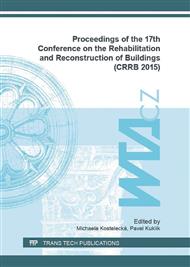p.111
p.116
p.122
p.128
p.137
p.143
p.148
p.152
p.159
Structural Studies of Nanofiber Membranes
Abstract:
Recently, the modeling of physical properties of nanofiber textiles has attracted a lot of attention. Since standard macroscopic models cannot satisfactorily explain the observed properties of such materials, it is necessary to develop models based on the knowledge of exact microscopic structure of nanotextiles. In this paper, we study the microscopic structure of two types of polymer membranes, made of PVDF (polyvinylidene fluoride) and PUR (polyurethane). The membranes were bought from Technical University of Liberec, where they have been were produced on NanospiderTM - NS 4S1000U setup. The samples were produced at various speeds of substrate (10, 25 and 50 mm/min). By the gravimetric analysis we have found the linear dependence of grammage (mass per square meter) on inversed speed of substrate. The nanofiber structure was observed by electron scanning microscope (SEM) Tescan Maia 3. Subsequently cross sections of the sample were obtained by various methods. The thickness and internal structure of the membrane was determined from these cross sections. It was found that the internal structure is very similar to the surface structure. Based on these observations we have determined parameters important for development of a 3D model of the nanofiber network.
Info:
Periodical:
Pages:
137-142
Citation:
Online since:
September 2016
Authors:
Keywords:
Price:
Сopyright:
© 2016 Trans Tech Publications Ltd. All Rights Reserved
Share:
Citation:


